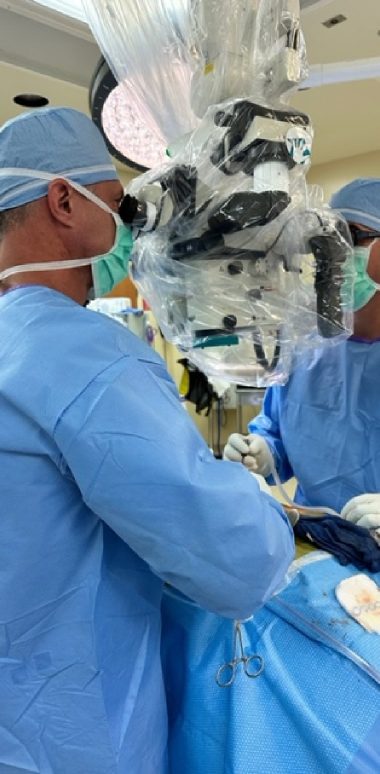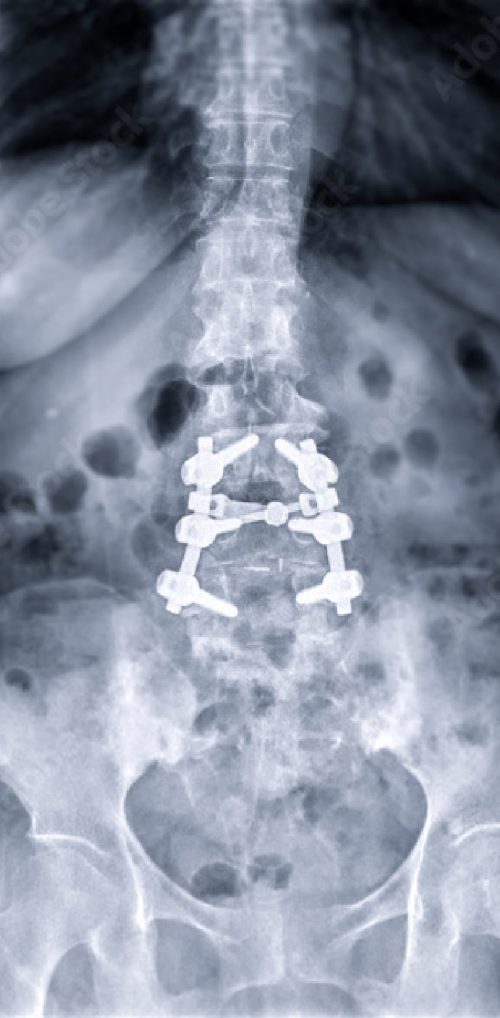SPINAL IMPLANTS

REVOLUTIONIZING SPINAL SURGERY
A COMPREHENSIVE GUIDE TO SPINAL IMPLANTS & INNOVATIVE DESIGN
Spinal implants are one of the most exciting parts of neurosurgery today. Researchers continue to develop various devices that simulate the body’s movements or stabilize them to help patients live more normal lives. Two examples of newer spinal implants include artificial spinal discs which preserve the patient’s range of motion more than spinal fusion and state of the art rods and screws that provide support in cases where fusion is necessary.
While patients can track the development of spinal implants to be more informed about their options, it is essential for surgeons to know about the latest advancements and technology. By offering the best possible treatment for patients, surgeons can provide long-term solutions that improve their overall quality of life.
Dr. K. Brandon Strenge, a fellowship-trained orthopedic spine surgeon in Paducah, KY, is a leading spinal surgeon at the cutting edge of advancements in spinal implant development and a principal investigator for several clinical trials. Learn how Dr. Strenge uses spinal implants and his process to make sure every patient is a good fit for the treatment they receive.




UNDERSTANDING
SPINAL IMPLANTS
Developing spinal implants is a complicated process. Not only do researchers need to create implants that fit within the human body, but these items cannot have any secondary effects on the patient as a whole. The specific techniques for placement and use of these implants also contribute to how effective they are. Here are a few things to know about spinal implants.
Types of Spinal Implants
Different types of spinal implants are used for a variety of treatments. When you work with Dr. Strenge, he might use one specific implant to treat your back pain or take a multi-faceted approach to stabilizing your spine. These are some of the implants Dr. Strenge uses:
Artificial discs: these are used instead of spinal fusion. The discs act just like the natural ones in your body and are significantly more durable.
Rods: these are used for spinal fusion. They stabilize the vertebrae so they don’t knock against each other. Some surgeons also use expandable rods to treat scoliosis without fusing the vertebrae.
Cages: a cage is another way to complete spinal fusion. The cage protects the vertebrae and holds them in place. These are also commonly called spacers.
Plates and screws: some doctors use plates to stabilize the spine and insert screws to hold everything in place.
The spinal implants Dr. Strenge uses will depend on the patient. Some people might benefit from artificial discs while others might need cages or spacers to stabilize their vertebrae.
Material Selection for Spinal Implants
The materials used to create artificial discs need to be durable but also sensitive to the human body’s needs (biocompatible). If a patient’s body rejects the implant, the patient might experience severe pain as the body reacts to the foreign object inside of it. Surgeons also have to worry about patients having allergic reactions to certain materials.
To accommodate the majority of patients, most implants are made of a titanium alloy that is proven effective when used in the human body. It is extremely rare for any patient to have an allergic reaction to implants made out of titanium. Other implants use a cobalt-chromium metal alloy or a combination of metal and polyethylene (ultra-high molecular weight plastic). Some implants are even created from high tech plastics and ceramic which are even more unlikely to cause an allergy.
By developing multiple implants for the same procedure, doctors can choose materials that are ideal for specific patients based on their physiology.
Surgical Techniques and Placement
Once a doctor chooses specific implants that are made of the best possible materials, they can use advanced surgical techniques to effectively place these items. The implants need to work with the body, not interfere with it. If a rod or plate is out of place, the patient could experience significant pain levels and have trouble recovering fully. This is what surgeons train for. They ensure every implant is precisely aligned in the most minimally invasive procedure possible.
ADVANCEMENTS
IN SPINAL DESIGN
While spinal implants have come a long way over the past decade, especially as more doctors embrace spinal disc replacement instead of fusion, there is still room for improvement. Here are a few ways that researchers are improving spinal discs through the support and leadership of surgeons like Dr. Strenge.
Bioengineering and 3D Printing
Each body is different, which means implants will fit better for some people than others. Through 3D printing, surgeons can develop implants based on the patient’s needs – significantly expanding their treatment options.
In one study, a 3D printer was able to make cages for spinal fusion patients at four different heights to account for different patient needs. This is particularly exciting for a surgeon like Dr. Strenge who is already a leader in expandable cage systems.
Patient-Specific Implants
The goal of 3D printing in neurosurgery and other bioengineering systems is to eventually create personalized implants for each patient. Doctors will develop a map of the patient’s body and understand the exact size and shape requirements to create artificial discs and other support tools. These customized designs increase the chances that the body accepts the implant and that patients live comfortably with them.
It’s amazing how far spinal disc replacement has come in only two decades. The first artificial disc was only just approved by the FDA in 2004. Patients had one option to choose from. Today, doctors are already creating patient-specific discs, which means no two 3D printings will look the same.
Artificial Intelligence and Design Optimization
Several neurosurgeons are tapping into the development of artificial intelligence (AI) to use it for spinal implants and surgical optimization. In 2012, there were just over 20 publications that talked about the use of AI in spinal surgery. A decade later, there were more than 160 publications that discussed this connection.
AI is a valuable tool for medical imaging because it can take photos and scans of patients’ spines and develop implant models to support them. This can speed up the 3D development process so doctors can create personalized implants faster.
AI also helps doctors mitigate risks with data-driven decision-making. They can identify important risk factors before and during surgery. This helps surgeons make better decisions that improve long-term patient outcomes.





CLINICAL CONSIDERATIONS FOR SPINAL IMPLANTS
As surgical implants become more flexible and personalized, more patients become candidates for these tools. This is great news for people who are living with back pain as they can embrace permanent solutions and take their lives back. However, there are still careful considerations to determine whether a patient is a good fit for this surgical operation. Here are a few ways Dr. Strenge and his colleagues evaluate patients.
Patient Selection
Experienced doctors never rush into surgery. They work carefully with their patients to learn their medical history and lifestyle to determine if they are good candidates who could recover fully from the operation. Doctors also strive to carefully diagnose their patients and try non-invasive options to see how their bodies respond.
If the patient is a candidate for surgery and needs the operation to live comfortably, Dr. Strenge will look at the surgical implant options available. He will determine which procedure is the best based on the individual patient’s needs. For example, while more patients are candidates for artificial disc replacement, some will respond better to spinal fusion.
There’s no need to take a one-size-fits-all approach to neurosurgery. The more personalized the treatment, the more likely the patients will have successful long-term results.
Complications and Risk Mitigation
While spinal surgeons want to promote the best possible outcomes for patients, they also need to consider the risks that come with every procedure. The spinal implants they choose and the operational plans they develop are meant to reduce the chances of infection after surgery while increasing the chances of a full recovery. This is why doctors often start with non-invasive treatment first – the risk is lower for patients than a full operation.
If a patient needs spinal surgery, doctors will use minimally invasive techniques when possible. This makes the procedure faster and speeds up the healing process. After the operation, patients follow detailed recommendations to promote healing and prevent infection. Doctors often schedule multiple follow-up appointments to make sure their patients are on the right path.
Surgical implants are not recommended lightly. Experienced surgeons work with patients before, during, and after the operation to make sure these interventions have high levels of success in the long run.
EXPERT IN SPINAL IMPLANTS
Meet Dr. Strenge: Paducah’s Top Spinal Surgeon
If you live near Paducah, KY, or its surrounding areas, choose Dr. K. Brandon Strenge for your orthopedic treatment. He is one of the leading spinal surgeons across the country and continues to invest in innovative ways to treat patients.
Dr. Strenge earned his medical degree from Southern Illinois University in 2003 and completed his fellowship in spinal surgery at the Spine Institute in Santa Monica, California in 2009. Since then, he has grown his skills in the field of spinal implants and currently sits as the principal of multiple clinical trials. Dr. Strenge is focused on developing minimally invasive techniques to help patients recover from spinal procedures faster.
Dr. Strenge is a member of the American Academy of Orthopaedic Surgeons, the North American Spine Society, the Society for Minimally Invasive Spine Surgery, the International Society for the Advancement of Spine Surgery, and the Southern Orthopaedic Association.

Case Studies and Success Stories
Highly recommend!
“Dr. Strenge is wonderful, he is very kind and takes his time to explain everything. My husband had his back fusion and we are very thankful we had Dr.Strenge. Thank you to him and his staff.”

Jojo,
Developer
NOTHING BUT THE UTMOST RESPECT FOR DR. STRENGE
“My case was an emergency surgery and he Aced it. 10 years later and I have no pain and no further back problem. So based on my experience, I will always recommend him and trust him! Thanks Dr. Strenge, you’re one hell of a surgeon!”

NANCY ROMANS,
Media Director
DR. STRENGE IS A EXCELLENT SURGEON
“I am originally from Michigan I am glad I was referred to him. Thank you!”

PATRICIA HORTON,
Designer
I HIGHLY RECOMMEND THEM!!!
“I had back surgery a year ago this month, and when I emailed him about concerns he almost immediately would get back to me. He staff is also amazing! I HIGHLY recommend them!!!”

JEN,
Manager
Follow Dr. Strenge to Improve Your Surgical Aptitude
The medical field is constantly changing as leading surgeons embrace new technology and tools to drive better patient outcomes. Dr. Strenge is one of the top surgeons in the country because of his commitment to learning and embracing advancements for better results for his patients. From developing personalized implants to utilizing 3D printing and artificial intelligence, he is always on the cusp of new treatments.
The world of surgical spinal intervention has come a long way in just two decades, and the future is bright for its continued advancement and growth. Keep up with Dr. Strenge and work with him to embrace innovation and continue advancing your knowledge in this field. Together, surgeons across the country can help patients live comfortable, pain-free lives.

FREQUENTLY ASKED QUESTIONS
What are the emerging trends in spinal implant technology?
One of the most exciting parts of spinal technology is the use of personalized implants. Instead of expecting each patient to use the same implant designs, 3D printing and AI work together to create personalized implants that are more likely to last.
Are patient-specific implants accessible to all patients?
Patient-specific implants are new to the surgical field. Very few doctors know how to develop these implants and use them. While they might be accessible to all patients in the future, they are not common right now.
How can I contact a spinal surgeon for more information or to discuss my case?
Meeting with a spinal surgeon is as easy as requesting an appointment. Schedule a consultation with Dr. Strenge or a trusted spinal surgeon near you if you live with back pain and think you are a good candidate for surgery.
Can I lead an active lifestyle after spinal surgery with implants?
Yes. The goal of surgical implants is to help patients live pain-free lives without sacrificing their range of motion. Many people can resume their favorite sports, hobbies, and activities after surgery because of the implants used.







REVOLUTIONIZING SPINAL CARE
At STRENGE Spine Center, we recognize every spine is different. Our personalized treatments, leverage innovative, research-driven surgical solutions to provide the best in spinal care that empowers patients towards a life of comfort, mobility, and renewed vitality.
All treatmentLATEST FROM STRENGE SPINE CENTER
IDEAL Symposium in Dallas
On May 17-18, Dr. Strenge participated in the IDEAL Symposium in Dallas, TX. Dr. Strenge discussed the Barricaid procedure to prevent re-herniation and re-operation after a disc herniation procedure.
Posterior Cervical Fusion at Strenge Spine Center, Paducah, KY
Posterior cervical fusion is a surgical procedure performed by Dr. K. Brandon Strenge at Strenge Spine Center in Paducah, KY, to address various spinal health issues affecting the cervical (neck) region of the spine.
Scoliosis Symptoms & Treatments in Paducah, KY – Dr. Strenge
Scoliosis is an abnormal curvature of the spine that causes the spinal column to form an “S” shape or a “C” shape. While a small degree of scoliosis may not cause any issues, moderate and severe scoliosis can cause pain, difficulty walking, fatigue, and even breathing abnormalities.
Expert Lateral Lumbar Interbody Fusion (LLIF) in Paducah, KY
Lateral Lumbar Interbody Fusion (LLIF) is a cutting-edge, minimally invasive surgical technique that Dr. K. Brandon Strenge specializes in at his practice, Strenge Spine Center, located in Paducah, Kentucky.
Strenge Spine Adds EOSedge System
Paducah, Ky.-based Strenge Spine Center added the EOSedge spinal imaging system.
2 level Cervical ADR Case Study – J.A.
Case study for J.A., a 57 yo male retired military veteran who served in the Army
Strenge Spine Center Launches Cutting-Edge Spine Care Solutions
Strenge Spine Center, a pioneering provider of advanced spine care, is proud to announce the launch of its state-of-the-art technologies and innovative treatment options, including the EOSedge system.
2 level Lumbar ADR Case Study – K.W.
Case study for K.W., a 27 yo female teacher and tournament cornhole player
Minimally Invasive Posterior Cervical Revision Fusion Case Study – J.S.
Case study for J.S., a 46 year old male weight lifter who originally had neck pain with severe left shoulder and arm weakness
FOLLOW US @STRENGESPINECENTER









